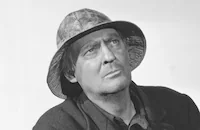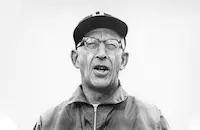Sadie Thompson

Brief Synopsis
Cast & Crew
Raoul Walsh
Gloria Swanson
Lionel Barrymore
Raoul Walsh
Blanche Frederici
Charles Lane
Film Details
Technical Specs

Synopsis
Sadie, a girl trying to hide her identity in the South Seas, meets Sergeant O'Hara, a marine, and promises to marry him. Alfred Atkinson, a tyrannical reformer, obsessed with her "immorality," makes life unpleasant for her and threatens to give her up to the police. When she reforms, he seduces her and then commits suicide. She is reunited with her lover, and they leave for Australia.

Director

Raoul Walsh
Cast

Gloria Swanson

Lionel Barrymore

Raoul Walsh
Blanche Frederici

Charles Lane
Florence Midgley
James A. Marcus
Sophia Artega
Will Stanton
Crew

Videos
Movie Clip


Film Details
Technical Specs

Award Nominations
Best Actress
Best Cinematography
Articles
Sadie Thompson (1928) -
Hollywood studios were reluctant to make the film. The 1920s had been a decade of scandals - murders, suicides, and drug deaths all made the headlines and caused reformers to try to shut the film industry down. Hollywood responded by cleaning up films and appointing former Postmaster General Will H. Hays as censor. As Gloria Swanson would learn to her delight, while Rain was only one of many books and plays that were banned from the screen, Maugham's original story Miss Thompson was not. She invited Hays to lunch and told him that she wanted to make a film of Miss Thompson, promising to cut out anything that would reflect badly on the clergy. In order to convince Maugham to sell the story to her, she needed Hays to give his approval. Hays consented and Swanson turned to producer Joseph Schenck to negotiate the sale. Schenck offered Maugham $100,000 for the story (which is what Maugham had asked for the now banned play). Using third parties to keep the news out of the papers, the successful transaction was announced to Swanson in a coded telegram which read: "Very happy to advise you are now owner of the two molehills of Nebraska."
Swanson chose to announce that she had purchased Maugham's story at the same time that Charles Lindbergh made his historic flight across the Atlantic, thinking that Lucky Lindy would distract everyone. It didn't distract the The New York Times, which picked up the story. Unfortunately, her fellow producers caught wind of the sale and protested that the property had been banned, lodging a complaint with Hays. Schenck had to assure Hays and the censor board that United Artists (acting as distributor for Gloria Swanson Productions) would not distribute a film of Rain and that Swanson had no intention of having a "preacher in the cast of characters [...] thus eliminating all possible objections on the part of the clergy as far as Sadie Thompson is concerned." Hays was pacified but the producers (informally known as "The Pinochle Club") was furious and did everything they could to stop her.
Eventually, Swanson was able to clear the property, thanks to Joseph Kennedy and MGM chief Marcus Loew. Sensing that she could have a hit on her hands, Swanson tried to hire Maugham to write a sequel to Sadie Thompson. Maugham wired back that Winifred Sheehan and William Fox, two of the objecting producers, had already hired him to write the sequel. Their hypocrisy stung and reinforced Swanson's belief that they didn't want to accept her as a producer.
In order to get Sadie Thompson made, Swanson had put in $200,000 of her own money and was forced to sell some of her properties to do it. She handpicked the cast herself. Swanson wanted Lionel Barrymore to play the now "reformer" Mr. Davidson, and Raoul Walsh, who had been an actor since the days of D.W. Griffith, as director. For her lover Tim "Handsome" O'Hara, Swanson auditioned several actors, among them Edmund Lowe and a 17-year-old Douglas Fairbanks, Jr., but, as Walsh later said, "She turned them all down. Two weeks go by, and Joe Schenck comes to me and says, "You're never going to start this picture unless you play the part yourself." Rumor had it that Swanson wanted Walsh for something else and the two were said to have had an affair during production. Also in the cast were Blanche Friderici and Charles Lane.
Sadie Thompson began shooting in June 1927 at the United Artists Studios on Santa Monica Blvd in Hollywood. Rather than spend thousands to go on location to Pago Pago, the company shot the South Seas locations at nearby Catalina Island. Swanson had borrowed George Barnes from Samuel Goldwyn to shoot the film, but during production, Goldwyn pulled him off the picture. Swanson had to halt production until she could find a cameraman who could match Barnes' style. Mary Pickford offered her cameraman Charles Rosher, but his work didn't blend well. He was replaced with Robert Kurrle, who also didn't last. Finally, Swanson was able to get Oliver Marsh from MGM and it was he who finished the film. Due to these delays, the film ended production in September 1927. Sadie Thompson came in at a whopping $931,761.04. If the film flopped at the box office, it would have ruined Swanson and her career.
The pressure must have been enormous when the film previewed in San Bernardino in early November. Luckily for all concerned, Sadie Thompson was an unqualified hit when it was released on January 7, 1928, making $7,000,000 internationally and $1,000,000 at the U.S. box office. Critics were also dazzled and Swanson earned the best reviews of her career. It would also be her last big hit until 1950, when she was nominated for an Academy Award for Sunset Blvd, in which she played a washed-up silent film actress.
SOURCES:
http://afi.com/members/catalog/DetailView.aspx?s=&Movie=11838
The Internet Movie Database
Shearer, Stephen Michael Gloria Swanson: The Ultimate Star
Welsch, Tricia Gloria Swanson: Ready for Her Close-Up
By Lorraine LoBianco

Sadie Thompson (1928) -
Quotes
Trivia
Gloria Swanson (as Sadie) swore several times on screen, but as the title cards don't reflect this and the film is silent, it was released without censorship.
The play, written by John Colton and Clemence Randolph, opened in New York in 1923.
Notes
As part of the first Academy Awards, Gloria Swanson received a certificate of honorable mention for her work on this film. Cinematographer George Barnes received a certificate of honorable mention, in part for his work on this film and for his work on The Magic Flame and The Devil Dancer. Other films based on the W. Somerset Maugham story include the 1932 United Artists release Rain, directed by Lewis Milestone and starring Joan Crawford and John Huston and the 1953 Columbia production Miss Sadie Thompson, directed by Curtis Bernhardt and starring Rita Hayworth, Jose Ferrar and Aldo Ray.














